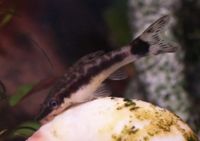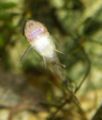Dwarf Oto (Otocinclus macrospilus)
From The Aquarium Wiki
Otocinclus macrospilus
11 Litres (3 US G.)
2.5-3.8cm (1-1.5 ")
Freshwater
6.0 - 8.0
21.1-26.1°C (70 -79 °F)
8-20 °d
1:2 M:F
3-5 years
Family
Loricariidae
Contents
Additional names
- Oto, Dwarf otocinclus, Golden otocinclus, Dwarf Otto, Dwarf Suckermouth Catfish, Midget Suckermouth Catfish
Sexing[edit]
- Difficult. Females are slightly bigger than males.
Tank compatibility[edit]
- An excellent peaceful community fish. There is, however, records of this fish sucking on slime coats of slow moving large bodied fish such as Angelfish and Discus. This is due to them be kept in near starvation condition in the fish shop and they've learned 'bad habits'.
Diet[edit]
- Otos will mainly graze on some soft algaes, primarily diatoms, and blanched vegetables such as Zucchini (Courgette), Carrot, Potato and Cucumber. They may also accept some algae wafers, but it can take some time to wean them onto these. They will not eat hair algae or green spot algae.
Also eat small live foods such as microworms.
Feeding regime[edit]
- They eat algae virtually all the time, so ensure they get enough.
Environment specifics[edit]
- A planted aquarium is a must. Ensure you get them in decent numbers, 3 or more is good. 6 or more is far better. They are a nervous fish if not kept in groups (in the wild they school in groups of several thousands) and have been know to die from stress if kept alone. As this small fish eats whilst resting on a surface, they are easy targets for larger fish in the wild.
Behaviour[edit]
- They tend to rest on any object, including the front glass so you'll get plenty of views of their underside.
Identification[edit]
- The O. macrospilus is mottled grey on the top half of the body, the lateral line is marked with a thick, but often broken, horizontal line which runs from the nose to the base of the caudal fin. The caudal markings are what separate this Otocinclus from the similar Otocinclus vestitus. On the O. macrospilus, there is a large round black spot at the base of the caudal fin with two faint vertical black bars running down the end of the tail.
- This fish is often incorrectly identified as Otocinclus affinis.
Special note[edit]
- These peaceful community fish are often starving when you see them in the average pet shop and consequently they have a reputation of having a high mortality rate within the first month of ownership.
- Some may have adopted a bad habit of scavenging for food by eating the slime coating of other fish.
- Ensure that you look at their bellies carefully in the shop and if they look very thin or hollow bellied then tell the shop to feed them more algae tablets or sliced fruit. These fish need to eat all the time.
- When you get them home (don't just own one or two), let them settle into a quiet tank and put in plenty of algae tablets and a sliced piece of fruit (see diet section) for them to chew on. The first month is fairly critical.
Pictures[edit]
Otos feeding on a slice of Zucchini (Courgette)
An Oto resting on a slice of Zucchini (Courgette)
Closeup of Oto showing its enlarged frontal ray and its odontodes
Video[edit]
| Dwarf Oto grazing: | Dwarf Otos Spawning: | Closeup of an Oto: |
External links[edit]
- ModestFish - Otocinclus care guide
- Fishbase (Mirrors:
 )
)






